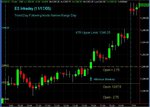Opening range break outs(ORB) has been a favourite technique used by many traders. I am starting this thread so that we can learn about this technique from the users of this forum.
Does any one here uses ORB's for their actual trading? or have used it in the past?
Why do ORB's work at all? I mean what is their foundation in the trader's psychology?
What works and what does not work in todays markets?
What was working in the past but is no longer working now ?
What has stopped working will it ever work again in the markets?
Do the ORB's work equally well in the Futures and Equity markets?
What happens when we apply filters for e.g range contraction on a previous day, is the pattern any more successful?
I watched the free portions of this presentation on ORB and found it to be useful
http://tradersstudio.com/Default.aspx?tabid=129
Has any one else watched it? Has anyone else got the full presentation and is it good?
Are there any good books or Stocks and commodities articles any one can recommend on ORB's.
I look forward to an interesting discussion and participation from the experienced users.
Does any one here uses ORB's for their actual trading? or have used it in the past?
Why do ORB's work at all? I mean what is their foundation in the trader's psychology?
What works and what does not work in todays markets?
What was working in the past but is no longer working now ?
What has stopped working will it ever work again in the markets?
Do the ORB's work equally well in the Futures and Equity markets?
What happens when we apply filters for e.g range contraction on a previous day, is the pattern any more successful?
I watched the free portions of this presentation on ORB and found it to be useful
http://tradersstudio.com/Default.aspx?tabid=129
Has any one else watched it? Has anyone else got the full presentation and is it good?
Are there any good books or Stocks and commodities articles any one can recommend on ORB's.
I look forward to an interesting discussion and participation from the experienced users.



